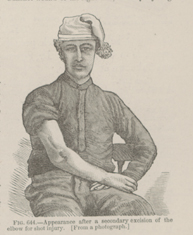Title: Tarbell, J. M.
Source text: The Medical and Surgical History of the War of the Rebellion. (1861-65.), Part 2, Volume 2 (Washington, DC: Government Printing Office, 1876), 887.
Civil War Washington ID: med.d2e31225
TEI/XML: med.d2e31225.xml
CASE 1822.—Private J. M. Tarbell, Co. E, 2d U. S. Sharpshooters, aged 21 years, was wounded at the Wilderness, May 6, 1864, and was admitted into a field hospital of the Second Corps, and thence sent to Washington, and received into Harewood Hospital on the 26th. Surgeon R. B. Bontecou, U. S. V., noted: "Gunshot wound of the right arm, severely injuring the elbow joint. On admission, the parts were considerably swollen and inflamed, and the constitutional state of the patient was very poor. The arm was kept quiet, and cold applications with general constitutional treatment employed until June 18th, when an operation was deemed necessary, which was performed, on that day, by Surgeon R. B. Bontecou, U. S. V., who resected the elbow joint. The patient improved in health after the operation, and, at this date, December 26, 1864, the wound has entirely healed and the patient is about to be discharged from service. He has no ability to flex the right arm, which is about two inches shorter than the left, but in other respects useful. Splints, simple dressings, and supporting treatment." The photograph from which the cut (FIG. 644) is taken, together with the specimen (FIG. 643), was contributed by the operator. The specimen consists of two fragments of carious bone, representing the condyles of the humerus, the olecranon, and head of the radius, excised from the right elbow. Tarbell was discharged from service December 31, 1864, and pensioned. Examiner C. L. Allen, of Vermont, reported, August 3, 1873: "A portion of the lower extremity of the humerus was removed by exsection. The right humerus is two and one-half inches shorter than the left. The right arm and forearm measure respectively, one and a quarter, and one and a half inches less than the left in circumference. There is complete loss of rotation of the hand except from the shoulder joint, the forearm can be extended, but can be flexed only to an angle of about one hundred and ten degrees; there is fair use of the hand. The forearm is evidently not strong, especially in pushing. The hand cannot be brought near enough to the head to be of any use in eating. Disability total." This pensioner was paid March 4, 1874.

